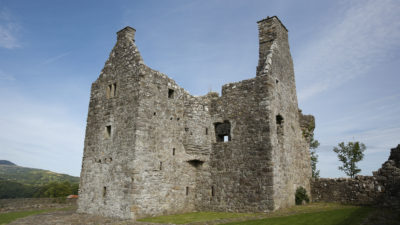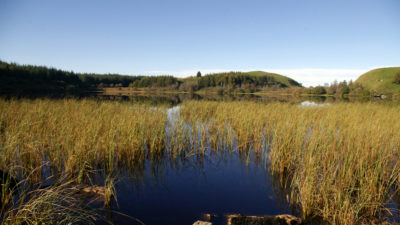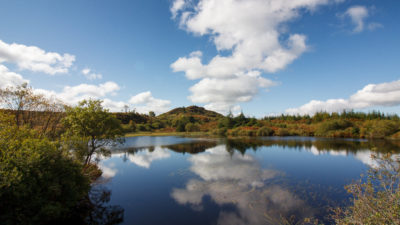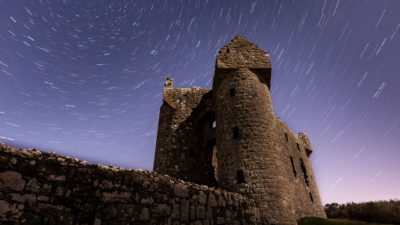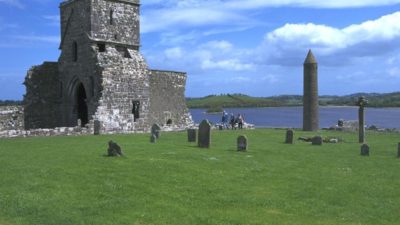
https://cuilcaghlakelands.org/geosite/castle-caldwell-forest/
Castle Caldwell Forest is a 200-hectare ancient woodland area with mixed broad-leaf comprising of ash, beech, oak, and holly as well as coniferous lowland forest located on a peninsular along the northern shores of Lower Lough Erne. Castle Caldwell is an outstanding site, for not only its peninsular position on the rugged shoreline of Lower Lough Erne but also for the dominated views of the remnants of the Castle estate itself.
The forest is located approximately 5 miles / 8km from Belleek, via the Boa Island Road.
Facilities: car parking, interpretation, picnic area, a jetty and three walking trails.
Castle Caldwell Forest
The Castle Scenic Walk offers a gentle and appealing introduction to the Castle Caldwell estate. After passing through a section of walled gardens, you will reach a gravel track leading to the foot of the icy clad ruins of the old castle.
The first part of the walk is along the peninsula shore. The path follows the new foreshore which is populated by alder and willow trees. Along the North facing stretch of the peninsula, views over Lower Lough Erne towards Boa Island and Kesh can be enjoyed before the path drifts away into the forest. The final stretch of the walk meanders through an area of broadleaf woodland, before opening up to reveal fine views of Castle Caldwell rising high above the forest floor.
Walkers who take time to explore the area will find the industrial-scale lime kiln. Another interesting feature which may be found at the eastern tip of the peninsula is the wall of the old strategic defence fort of Rossergole Point. Today the old ruins offer walkers a vantage point for breath taking views over Lower Lough Erne. Travelling onwards, the southern shore of the peninsula forms part of the Lower Lough Erne Nature Reserve, managed by the Royal Society for the Protection of Birds (RSPB). Continuing onward you will shortly join a forest track where its course carries you through attractive stands of ash trees and into denser forest before taking in the remnants of Castle Caldwell, a prominent feature within the woodland setting.
The ruins of Castle Caldwell are undoubtedly the most striking feature within Castle Caldwell Forest. Built in 1612 as part of the Plantation of Ulster by Sir Francis Blennerhasset, the name of the castle actually comes from James Caldwell, an Enniskillen merchant who purchased the estate in 1662. Sir James Caldwell spent a further £16,000 building, ‘a most comfortable good house, a very large court of excellent offices, …two very large walled gardens with fish ponds, a beautiful temple built on the Black Rock glazed with painted glass’, Caldwell Castle the Beautiful Seat of Sir James Caldwell in Ireland. F. Newbery, London (1780).
During the 1840s the Caldwell family fortune declined, leading to the entire estate, including the village of Belleek, being passed to John Caldwell Bloomfield. It was Bloomfield who commissioned a geological survey of the estate, revealing rich mineral deposits of Feldspar and Kaolin (China clay). These minerals are important raw materials used in the production of fine China and so Bloomfield capitalised on his good fortune by founding the now world-famous Belleek Pottery.
The industrial-scale lime kiln on site highlights the importance of the local limestone, once frequently fired in the kiln to produce quicklime, and taken by barge to Belleek Pottery.
Although the castle was eventually abandoned in the 1900’s, if local ghost stories are to be believed, the ruins are still haunted by Dennis McCabe, a fiddler who drowned after falling off the Caldwell family barge. A copy of the fiddler’s gravestone with its amusing inscription can be seen at the main entrance to the forest.
The first part of the Beech Wood Walk is along the peninsula shore that would have been submerged by water up until the 1880’s when the lowering of Lower Lough Erne (by approximately 3m) exposed new land and new habitats developed. The path follows the new foreshore which is populated by alder and willow trees, whilst higher up on the banks oak and beech trees indicate the former water’s edge.
Another interesting feature which may be found at the eastern tip of the peninsula is the wall of the old strategic defence fort of Rossergole Point. This fortification no doubt played a vital role in protecting and controlling trade along this route.
You may even catch a glimpse of some of the shy woodland mammals that inhabit this beautiful place such as the pine marten. The varied habitats within the forest and along this shoreline have attracted many types of birds, including many species of water birds and songbirds.
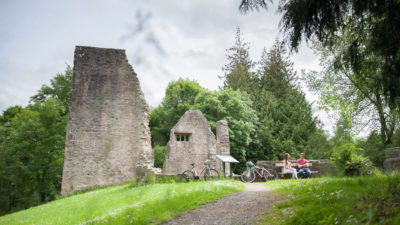
Drumshane, Fermanagh
A 520 hectare mixed broadleaved and coniferous lowland forest located on the sho...
Church Hill, Fermanagh
Nestled on the shores of Lower Lough Erne, are the impressive remains of a forti...
Doagh Glebe, Fermanagh
Carrigan Forest is the gateway between two significant expanses of upland forest...
Blaney, Fermanagh
The outlook from the Carrickreagh Viewpoint is spectacular.
Scribbagh, Fermanagh
Big Dog Forest, cloaked largely with conifers, dotted with open stretches of upl...
Enniskillen, Fermanagh
A stunning site, giving visitors views of one of the largest and best preserved ...
Enniskillen, Fermanagh
The early Christian Monastery and round tower at Devenish is one of Ireland’s mo...
Distances are from Castle Caldwell Forest
